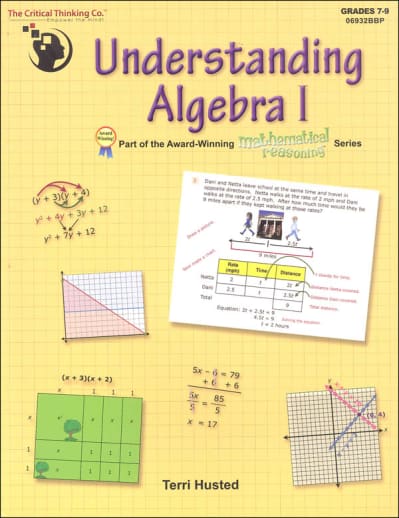The word 'Algebra' can strike fear into the hearts of many, but Critical Thinking Press has done their part to calm your math nerves and prepare students for higher level math in Understanding Algebra. The newest member of the Mathematical Reasoning line is a full one year algebra course for students at the junior high and high school level in a consumable format.
The information in this worktext is a user-friendly format and presented in a step-by-step fashion. The text makes a connection between the arithmetic of the elementary years to the algebra they need to succeed in high school math. Twelve chapters begin with the basics and build upon each other Our number system, Evaluating Expressions and Solving Equations, From Words to Algebra/Translating and Solving Word Problems, From Words to Algebra/More Word Problems, Inequalities, Polynomials, Factoring, Working with Radicals, Linear Functions, Systems of Equations and Inequalities, Other Types of Functions, and Working with Algebraic Fractions.
The author begins the book with a simple explanation of "What is Algebra," and then jumps right in. Each chapter is 20 to 30 pages in length and broken into topics. Each topic or lesson offers the student explanations and examples in a very visual fashion. Colored charts, illustrations, and graphs are incorporated for clarity of explanations. Within the lessons, students will be asked questions to assure they know the concept being presented and a 'more practice' section rounds out the lesson. Sets of 'Enrichment Problems' are scattered throughout the chapters to offer additional practice in higher-order thinking using plenty of word problems. There are no chapter tests in this book, so you would need to assess your student's understanding of the concepts by other means grades from the practice sets and exercises might be your best tool for assessment.
New for the 2017 edition are chapter reviews covering and a final exam.
A glossary that includes algebra vocabulary and an answer key are found at the back of the book. These are answers and not solutions. A helpful reference page is included. Students will learn about the history of math as they learn math strategies to help them with algebra and beyond. 378 pgs. pb. Reproducible for home and single classroom use. COMPLETE SOLUTIONS ARE AVAILABLE FREE ON THE PUBLISHER WEBSITE. ~ Donna

